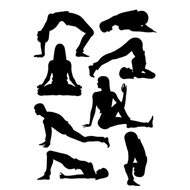- Raja yoga
- Yoga Stretches
- Jivamukti Yoga Poses
- Yoga Tree Pose
- Sun and Moon Yoga
- Wind Removing Pose
- Hare Pose
- Accomplished Pose
- Urdhva Mukha Pinch Mayurasana
- Revolved Abdomen Pose
- Raised Foot Pose
- Scorpion Pose
- Butterfly Pose
- Half Tortoise Pose
- Revolved Twist
- Balancing Stick Pose
- Cat Pose
- Supported Shoulderstand
- Crane Pose
- Handstand
- Happy Baby Pose
- Scale Pose
- Side Plank Pose
- Upward Facing Two-Foot Staff Pose
- Reclining Big Toe Pose
- Stick Pose
- Revolved Head-to-Knee Pose
- Full Boat Pose
- Upward Extended Feet Pose
- Yoga arm balance poses
- Core Yoga
- Inversion Yoga Poses
- Seated And Twist Yoga
- Horse Pose
- Cobbler Pose
- Seated Wide Angle Pose
- The Compass Pose
- Half Crow Pose
- Bound Half Moon Pose
- Lotus Pose
- Reverse Warrior Pose
- Fixed Firm Pose
- Back-bend Poses
- Forward bend Poses
- Sarvangasana
- Ashtanga Yoga Poses
- Warm up poses
- Seated Poses
- Seated Forward Bends
- Chair Poses
- Standing Poses
- Standing Balancing poses
- Yoga Asanas
- Hatha Yoga Asanas
- Yoga Postures Online
- Partner Yoga Poses
- Anusara Yoga Poses
- Advanced Yoga poses
- Restorative Yoga Poses
- Kids Yoga Poses
- Beginning Yoga Postures
Firefly Pose (Tittibhasana)
Tittibhasana (Firefly Pose) is a posture that requires strength of the upper body and hamstrings that are flexible. However, even if you have not mastered these two, you can still practice this challenging posture.
This is an arm balancing posture that incorporates the legs flexibility with core strength. When the lower body is raised from the mat, the pose strengthens the shoulders and wrists further.
For you to remain elevated, a balance must be found by the lower body in distributing energy and weight back and forward equally.
The Firefly Pose in yoga gets its name because the position that you come into while performing the pose is similar to that of a flying firefly. This pose is one of the postures that need to be practiced consistently so as to perfect them. Unfortunately, the Tittibhasana or Firefly Pose is not taught regularly in the classes of Vinyasa. Ashtanga yoga is the exception, where this pose is part of the primary series, giving a good opportunity to perform this posture in every session. However, before taking up the Firefly Pose, it is important that you remember that it is considered an advanced posture. Therefore, if you do not have proper guidance or are not experienced enough, this posture should not be attempted. If your body is not prepared for the movements of this posture, you could risk an injury. However, if you are ready to practice this pose you should make sure to practice it regularly to experience the benefits. It is also essential that you maintain a proper diet to get the most out of this pose.
Steps :
- To start the Firefly Pose steps, you should first come into the squatting position; your feet should be at a lesser distance than your shoulders. Let your pelvis tilt forward and your trunk be brought between your legs. With your trunk kept low, let your legs straighten sufficiently to bring your pelvis to about the height of your knees.
- Then bring your shoulder and left upper arm as far as you can under your left thigh, a little above your knee. Let your left hand be placed on the ground at your foots outside edge with your fingers pointing in the forward direction. These actions should be repeated with the other side as well.
- By changing your body’s center of gravity, carefully you should bring yourself to come off the floor. Let your hands press down on the floor and start to slowly bring your weight away from your feet and to your hands. Your inner thighs should be placed as high up alongside your arms as is possible.
- After taking a deep breath, your legs should be stretched out to your sides where they should be kept as straight as possible. Your pelvis should be kept high so that your legs remain parallel to the ground.
- Then, let the bases of the big toes be pressed through, but with your toes pulled back to the torso; keep your toes spread apart. The inner portion of your feet should be in a slightly forward angle, and the outer part of your feet should be a little back.
- Let your arms be straightened as much as you can. Bring your chest to hollow out while you broaden your shoulder blades as far as you possibly can. This will make your upper back round, which will bring your torso higher.
- Without letting your neck tense, let your head be lifted up and look forward. Keep your breathing slow and remain in the position for 15 seconds or more. Then, let your feet be released to the floor while breathing out.
Precautions :
- It is important that you take certain precautions before performing this pose and avoid practicing this pose with certain conditions that can be made worse.
- Avoid this pose if you have a lower back injury, elbow and wrist injury, or shoulder injury.
- As this pose actively involves the shoulder, wrist, elbow and lower back, injury to these parts could be made worse with the performance.
- To support the wrists during this pose you could keep your hands on a sponge ball that is cut in half or on a yoga mat that is rolled up.
Beginner’s Tip :
Like most of the arm balances, this pose is not as difficult as it looks. A good beginner’s tip for the Firefly Pose is that this pose can be approximated by sitting on the ground, spreading the legs to a 90 degree angle, raising each heel on a block and letting your palms press into the ground between your legs. This pose is very effective for beginners to increase the strength of the wrists. For advanced students of yoga, the Firefly Pose is very effective in improving the overall sense of balance and strength of the body. You can go deeper into the pose by remaining in the last position for a longer duration of time than suggested and by breathing deeply.
Benefit To Body Part :
- The Firefly Pose focuses on strengthening the wrists.
- It increases the strength of the arms.
- It tightens and tones the area of the belly.
- It stretches the inner groins, hamstrings, and back torso.
- It strengthens the core.
Therapeutic Applications :
- Like most of the yoga poses, the therapeutic applications of the Firefly Pose is in calming the mind and bringing relief from anxiety, stress, and tension.
- The pose also helps in bringing an overall sense of balance and improves core strength.
Variations :
- One variation is to bend your knees and let the soles of your feet touch each other
- You could also try sitting on the ground and letting your heels rest on yoga blocks, as mentioned in the Beginner’s tip section.
Preparatory Poses :
- Garland Pose (Malasana)
- Cobbler’s Pose (Baddha Konasana)
- Eagle Pose (Garudasana)
- Crane Pose (Bakasana)
Follow Up Poses :
- Upward Facing Dog (Urdhva Mukha Svanasana)
- Standing Forward Bend (Uttanasana)
- Downward Facing Dog (Adho Mukha Svanasana)



